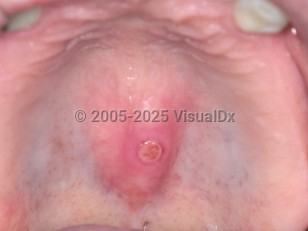Traumatic oral ulcer - Oral Mucosal Lesion
Alerts and Notices
Important News & Links
Synopsis

The traumatic oral ulcer is very common and can be caused by acute or chronic trauma from sharp objects, accidental or intentional biting, or overzealous brushing. The ulcer is usually solitary and can range from less than 1 mm to more than 1 cm in diameter. Typically the patient complains of mild pain during the first few days following the episode of trauma. With removal of the cause, healing takes place within 2-7 days. A superimposed candidal infection can impede healing, even in healthy patients. Sites commonly injured by the teeth include the tongue, lips, and buccal mucosa. Ulcers on the gingiva, palate and mucobuccal fold are usually related to hard, sharp edges of food or to toothbrush-induced injury. Thorough questioning of the patient may suggest the diagnosis.
The lesion appears as a round, ovoid or irregularly shaped removable, creamy-white fibrinopurulent membrane surrounded by a variable amount of erythema. For more chronic lesions, a white border of hyperkeratosis, the margins of which blend with the surrounding mucosa, is adjacent to the area of ulceration.
The lesion appears as a round, ovoid or irregularly shaped removable, creamy-white fibrinopurulent membrane surrounded by a variable amount of erythema. For more chronic lesions, a white border of hyperkeratosis, the margins of which blend with the surrounding mucosa, is adjacent to the area of ulceration.
Codes
ICD10CM:
K12.0 – Recurrent oral aphthae
SNOMEDCT:
50882004 – Traumatic ulcer of oral mucosa
K12.0 – Recurrent oral aphthae
SNOMEDCT:
50882004 – Traumatic ulcer of oral mucosa
Look For
Subscription Required
Diagnostic Pearls
Subscription Required
Differential Diagnosis & Pitfalls

To perform a comparison, select diagnoses from the classic differential
Subscription Required
Best Tests
Subscription Required
Management Pearls
Subscription Required
Therapy
Subscription Required
References
Subscription Required
Last Updated:11/21/2005
 Patient Information for Traumatic oral ulcer - Oral Mucosal Lesion
Patient Information for Traumatic oral ulcer - Oral Mucosal Lesion
Premium Feature
VisualDx Patient Handouts
Available in the Elite package
- Improve treatment compliance
- Reduce after-hours questions
- Increase patient engagement and satisfaction
- Written in clear, easy-to-understand language. No confusing jargon.
- Available in English and Spanish
- Print out or email directly to your patient
Upgrade Today

Traumatic oral ulcer - Oral Mucosal Lesion

